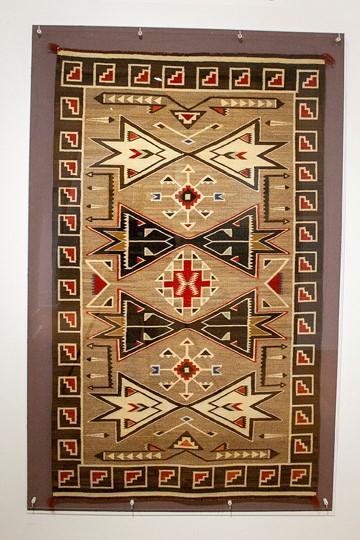
Teec Nos Pos Rug (circa 1915)

Teec Nos Pos Rug
Unknown weaver
1915 – 20
Bob: The border disrupts what would be horizontal and vertical symmetries. I see the border as a loop, or even a rotational symmetry mapped onto the rectangle. The border invites the eyes into motion around the weaving while the middle uses symmetry to emphasize the center—the one fixed point that the rotational and reflection symmetries share. This is a symmetry around an origin—a mathematical origin story.
Shimá/Henry: Feathers are used to communicate with the super-beings. Everyone has a feather—a spiritual connection that grounds who we are as an individual. The rug is a living, spiritual being. The more symmetry it has, the more whole you are going to be as a person. Usually the four mountains are mentioned in our stories, but there are really six mountains and they all are found in this weaving. The whole rug is the Universe. The center is the Earth—the Earth also has to have alignment and symmetry as balance. The borders are the cosmos, including the clouds and the stars.
Bob: I see several places where the weaving should be symmetrical but is not. In one location (see if you can find it) there is a shape with three points whereas the reflected image is not the same.
Shimá/Henry: The Navajo people say that where irregularity is happening, the Holy People will help you fix that asymmetry. You always give the Holy People room to do correction. We are not symmetrical people in life—we make mistakes. So, where that occurs, there is a struggle taking place in our life. We leave a little room for a higher being to help us construct that symmetry.